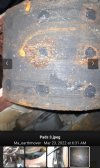The reason I asked about the number of brake pedals is that most modern wheel loaders have two brake pedals. See the illustration below. The pedal on the right operates only the brakes , the one on the left operates the brakes but also disconnects the transmission drive.
When the operator is dumping the bucket he uses the left pedal and as a result the machine is not pushing against the transmission so the hydraulics work faster. I've seen cases of brake wear on machines of that design where the operator was (incorrectly) using the right pedal for braking during dumping. I wanted to eliminate potentially incorrect operation as a factor in the brake wear problem.
Another reason that made me ask about the number of brake pedals was that you mentioned frequent failures of the seals in the calipers. That to me indicated heat, and also suggested the possibility of incorrect operation.
View attachment 255486


